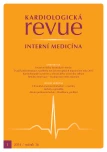-
Medical journals
- Career
Urinary tract infections
Authors: J. Vachek 1,2; O. Zakiyanov 1,3; V. Adámková 3; V. Tesař 1
Authors‘ workplace: Klinika nefrologie VFN a 1. LF UK v Praze 1; Farmakologický ústav 1. LF UK v Praze 2; Ústav lékařské biochemie a laboratorní diagnostiky VFN a 1. LF UK v Praze 3
Published in: Kardiol Rev Int Med 2014, 16(1): 74-77
Category: Internal Medicine
Overview
Urinary tract infections are one of the most frequent clinical bacterial infections in adults. Escherichia coli is the organism that causes urinary tract infections in most patients. Consensus guidelines have been published to assist clinicians with diagnosis and treatment of urinary tract infection; however, a single evidence‑based approach to diagnosis of urinary tract infection does not exist. There is no gold-standard definition of urinary tract infection that clinicians agree upon. In a subgroup of individuals with coexisting morbid conditions, complicated urinary tract infections can lead to upper tract infections or urosepsis. Although the initial treatment is antimicrobial therapy, use of different prophylactic regimens and alternative strategies are available to reduce exposure to antibiotics. Future studies improving the diagnostic accuracy of urinary tract infections are needed. This review will cover the prevalence, diagnosis and diagnostic challenges, management, and prevention of urinary tract infection and asymptomatic bacteriuria in adults.
Keywords:
asymptomatic bacteriuria – antibiotic treatment – cystitis – Enterobacteriaceae – urinary infections – pyelonephritis
Sources
1. Litwin MS, Saigal CS, Beerbohm EM. The burden of urologic diseases in America. J Urol 2005; 173 : 1065 – 1066.
2. Rüden H, Gastmeier P, Daschner FD et al. Nosocomial and community ‑ acquired infections in Germany. Summary of the results of the First National Prevalence Study (NIDEP). Infection 1997; 25 : 199 – 202.
3. Naber KG, Schito G, Botto H et al. Surveillance study in Europe and Brazil on clinical aspects and Antimicrobial Resistance Epidemiology in Females with Cystitis (ARESC): implications for empiric therapy. Eur Urol 2008; 54 : 1164 – 1175.
4. Urbášková P, Jakubů V, Žemličková H et al. Rezistence k antibiotikům u sedmi druhů invazivních bakterií, sledovaných v rámci EARSS v České republice v letech 2000 – 2006. Prakt lék 2007; 87 : 32 – 38.
5. Bartoničková K, Bébrové E, Beneš J et al. Doporučený postup pro antibiotickou léčbu komunitních infekcí ledvin a močových cest v primární péči. [online] Dostupné z: www.cls.cz/ dokumenty/ dp_imc.doc.
6. Gupta K, Hooton TM, Naber KG et al. International clinical practice guidelines for the treatment of acute uncomplicated cystitis and pyelonephritis in women: A 2010 update by the Infectious Diseases Society of America and the European Society for Microbiology and Infectious Diseases. Clin Infect Dis 2011; 52: e103 – e120. doi: 10.1093/ cid/ ciq257.
7. Naber KG, Cho YH, Matsumoto T et al. Immunoactive prophylaxis of recurrent urinary tract infections: a meta‑analysis. Int J Antimicrob Agents 2009; 33 : 111 – 119. doi: 10.1016/ j.ijantimicag.2008.08.011.
8. Piccoli GB, Consiglio V, Colla L et al. Antibiotic treatment for acute 'uncomplicated' or 'primary' pyelonephritis: a systematic, 'semantic revision'. Int J Antimicrob Agents 2006; 28 (Suppl 1): S49 – S63.
9. Grabe M, Bjerklund ‑ Johansen TE, Botto H et al. Guidelines on Urological Infections. In (EDS). European Association of Urology Guidelines. Arnheim: EAU Guidelines Office 2011.
10. Vachek J, Tesař V, Zakiyanov O et al. Farmakoterapie v těhotenství a při kojení. Praha: Maxdorf 2013.
11. Toršová V, Chmelařová E. Antibiotika v těhotenství. Interní Med 2001; 12 : 550–552.
Labels
Paediatric cardiology Internal medicine Cardiac surgery Cardiology
Article was published inCardiology Review

2014 Issue 1-
All articles in this issue
- Beneficial use of transcranial Doppler ultrasound in invasive treatment of carotid artery disease
- Permanent cardiac pacing in terms of the new European recommendations from 2013
- Cardiohepatic syndrome in patients with chronic heart failure
- Prognostic significance of liver enzyme elevations in acute coronary syndromes
- Development of kidney function parameters in patients with advanced heart failure treated with levosimendan – retrospective analysis
- Renal denervation – future or disappointment
- Deep venous thrombosis and pulmonary embolism associated with hormonal contraceptives use
- More arguments for conservative treatment of coronary artery disease in chronic form
- Complex nursing care documentation for short-term hospitalization of patients indicated for permanent pacemaker implantation
- Chronic kidney disease – a new classification and therapy
- Drug therapy in chronic kidney disease
- Acute kidney injury
- Rapidly progressive glomerulonephritides (crescentic glomerulonephritides)
- Selected renal diseases in pregnancy
- Urinary tract infections
- Cardiology Review
- Journal archive
- Current issue
- Online only
- About the journal
Most read in this issue- Acute kidney injury
- Selected renal diseases in pregnancy
- Rapidly progressive glomerulonephritides (crescentic glomerulonephritides)
- Drug therapy in chronic kidney disease
Login#ADS_BOTTOM_SCRIPTS#Forgotten passwordEnter the email address that you registered with. We will send you instructions on how to set a new password.
- Career

